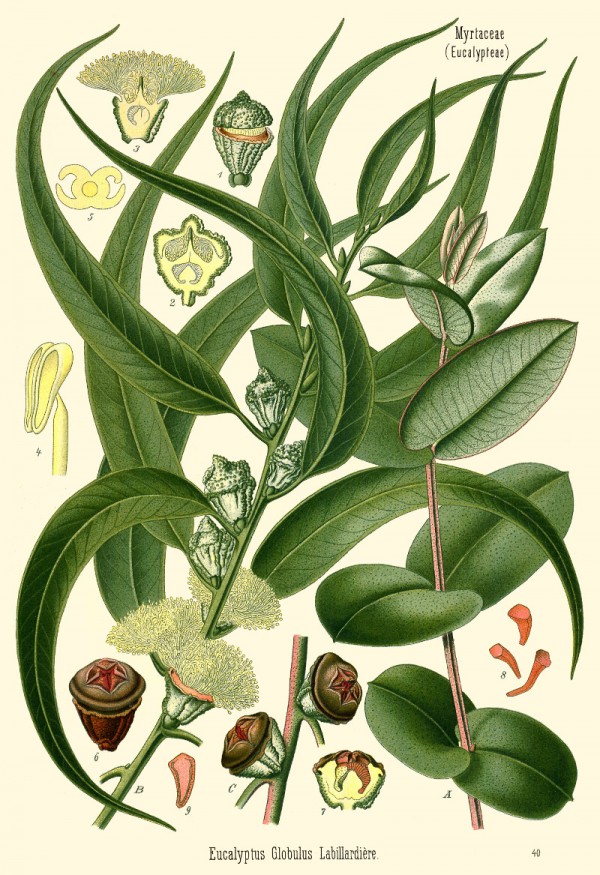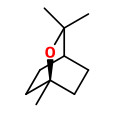Eucalyptus globulus Labill. - Myrtaceae - Tasmanian blue gum, southern blue gum, (Blauer) Eucalyptus, Blaugummibaum
Large evergreen tree, native to Australia (New South Wales, Victoria), Tasmania, naturalized elswhere.
„The species name is from the Latin globulus, a little button, referring to the shape of the operculum.“
http://en.wikipedia.org/wiki/Eucalyptus_globulus
Eucalyptus leaves are rarely used as medicine. Eucalyptus oil contained in the leaves (0.5-3.5%), is much more frequently used and consists mainly of 1.8-cineole (70-95%). http://de.wikipedia.org/wiki/Blauer_Eukalyptus
„…anti-inflammatory activity of the monoterpene 1.8-cineole in asthma and a new rational for its use as mucolytic agent in upper and lower airway diseases.“
[Anti-inflammatory activity of 1.8-cineol (eucalyptol) in bronchial asthma: a double-blind placebo-controlled trial. Juergens UR1, Dethlefsen U, Steinkamp G, Gillissen A, Repges R, Vetter H., Respir Med. 2003 Mar;97(3):250-6.]
„The toxic effects of Eucalyptus globulus leaf oil-derived monoterpenoids [1,8-cineole, l-phellandrene, (−)-α-pinene, 2-β-pinene, trans-pinocarveol, γ-terpinene, and 1-α-terpineol] and the known Eucalyptus leaf oil terpenoids (β-eudesmol and geranyl acetate) on eggs and females of the human head louse, Pediculus humanus capitis, were examined using direct contact and fumigation bioassays… 1-α-Terpineol and (E)-pinocaveol were highly effective at 0.5 and 1.0 mg/cm2, respectively, against P. h. capitis eggs. At 1.0 mg/cm2, (−)-α-pinene, 2-β-pinene, and γ-terpinene exhibited moderate ovicidal activity, whereas little or no ovicidal activity was observed with the other terpenoids and with δ-phenothrin and pyrethrum. In fumigation tests with female P. h. capitis at 0.25 mg/cm2, 1,8-cineole, (−)-α-pinene, (E)-pinocarveol, and 1-α-terpineol were more effective in closed cups than in open ones, indicating that the effect of the monoterpenoids was largely due to action in the vapor phase.“
[Ovicidal and adulticidal activity of Eucalyptus globulus leaf oil terpenoids against Pediculus humanus capitis (Anoplura: Pediculidae)., Yang, Y.C., Choi, H.Y., Choi, W.S., Clark, J.M., Ahn, Y.J., Journal of Agricultural and Food Chemistry, 52(9), 2004, 2507-2511]
Main components of the essential oil were 1,8-cineole (52.6%), α-pinene (20.0%), α-phellandrene (6.1%), α-terpinyl acetate (3.6%), γ-terpinene (1.1%), and globulol (1.2%).
[Comparative evaluation of 11 essential oils of different origin as functional antioxidants, antiradicals and antimicrobials in foods. Sacchetti, G., Maietti, S., Muzzoli, M., Scaglianti, M., Manfredini, S., Radice, M., Bruni, R., Food Chemistry, Vol.91, 2005, 621-632]
Eucalyptus globulus essential oil showed antibacterial activity against Haemophilus influenzae, Haemophilus parainfluenzae, Stenotrophomonas maltophilia and Streptococcus pneumoniae obtained from clinical specimens of patients with respiratory tract infections. „The antiviral activity, assessed by means of virus yield experiments titered by the end-point dilution method for adenovirus, and by plaque reduction assay for mumps virus, disclosed only a mild activity on mumps virus.“
[Effect of eucalyptus essential oil on respiratory bacteria and viruses., Cermelli, C., Fabio, A., Fabio, G., Quaglio, P., Current microbiology, 56(1), 2008, 89-92]
„Chemical composition of E. globulus oil revealed 1,8-cineole (33.6%), α-pinene (14.2%) and d-limonene (10.1%) as major constituents, while vapour profile of E. globulus oil determined through solid phase microextraction (SPME) analysis showed 1,8-cineole (56.5%), α-pinene (16.9%), d-limonene (5.5%) and linalool acetate (3.4%) as principal components.“
[Compositional analysis and insecticidal activity of Eucalyptus globulus (family: Myrtaceae) essential oil against housefly (Musca domestica)., Kumar, P., Mishra, S., Malik, A., Satya, S., Acta tropica, 122(2), 2012, 212-218]
„Eucalyptus honey is characterized by [the sweet chocolate smelling] 2-hydroxy-5-methyl-3-hexanone and 3-hydroxy-5-methyl-3-hexanone, as well as exo-2-hydroxycineole and an unknown norisoprenoid. Aside from, acetoin, nonanal, methyl nonanoate, and dehydrovomifoliol were present in higher concentrations. In eucalyptus flower extracts, norisoprenoids were the most abundant compounds, all of which were also present in the honey samples. 3-Oxo-α-ionone comprised half of the total amount, followed by eucalyptol.“
[Alissandrakis, Eleftherios, et al. „Investigation of organic extractives from unifloral chestnut (Castanea sativa L.) and eucalyptus (Eucalyptus globulus Labill.) honeys and flowers to identification of botanical marker compounds.“ LWT-Food Science and Technology 44.4 (2011): 1042-1051]

Köhler, F.E., Medizinal Pflanzen, vol. 3: t. 40 (1890)
http://www.plantillustrations.org/species.php?id_species=410554
Eucalyptus globulus, Botanischer Garten der Universität Wien
© Rolf Marschner (2014),
www.botanische-spaziergaenge.at


